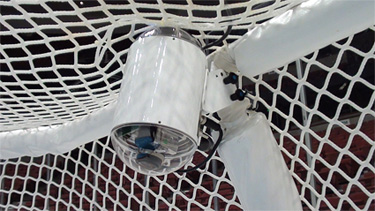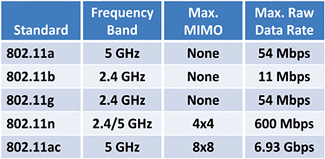Uncompressed Wireless HD

Moving 1.5 Gbps HD signals from one place to another has long been the exclusive domain of wired systems. These could be baseband wired systems (coax, anyone?), fiber-optic systems, or high-speed (10 Gig) Ethernet systems. But until recently, it hasn't been feasible to transmit these high-speed signals over wireless connections. Now, some new technologies are emerging that have the bandwidth capacity to handle these jumbo-size bit streams.
COFDM
Broadcasters have long used private microwave systems for transporting video signals at sports and other events where camera mobility is valuable. These systems, which often employ COFDM (Coded Orthogonal Frequency Division Multiplexing), typically use licensed frequencies that are coordinated at each venue to avoid interference between different users. Even though these systems have direct HD video inputs and outputs, the radio channel bit rates are not large enough to support uncompressed HD. So, these systems resort to using MPEG-2 and H.264 compression to get the signal to fit within the bit rate of the wireless stream.
60 GHZ
One way to get enough RF bandwidth for an uncompressed HD signal is to use a frequency band where there are fewer limitations and no license required, such as in the 60 GHz band. At least one company, VidOvation, has produced a 60GHz wireless link that is used for transmitting 1.5 Gbps video from an in-goal camera for ice hockey. In this application, the signal transport is one-way, and the receiver can be mounted in the ceiling rafters above the rink. Antennas with narrow beam widths (less than 5 degrees) are used for two reasons: to get higher gain in the direction that the antenna is pointing and to reduce the probability that a source of interference will be within the beam pattern of the receiver.

VidOvation Goalcam, deployed in the most recent NHL season, uses a 60 GHz wireless link to transmit 1.5 Gbps video from an in-goal camera.MIMO
Multiple Input, Multiple Output radio technology has been a big step forward for high-data rate applications. MIMO systems use multiple inputs to the radio channel (i.e. multiple RF transmitters each feeding a transmit antenna), and multiple outputs (i.e. multiple receive antennas each feeding an RF receiver). Advanced digital signal processing technology in the receiver section allows the different radio signals (which all share the same RF channel frequency) to be separated so that each of the incoming streams can be decoded using the principle of "spatial diversity." When MIMO systems are deployed, notations such as "2x2" or "4x4" are used to indicate the number of RF transmitters and RF receivers used in the system, with each TX or RX connected to a separate antenna.
Some current digital transmission systems use MIMO technology quite effectively. LTE (Long Term Evolution, often called 4G) mobile phone systems can use MIMO arrangements; in fact, many LTE base stations use MIMO technology to increase throughput and reduce gaps in coverage. The popular WiFi standard 802.11n (which operates in the 2.4 GHz frequency band) supports up to 4x4 MIMO, which gives a theoretical channel bit rate of 600 Mbps. Actual data throughput over such a link would be much lower, due to packet overhead, inter-frame gaps, the need to allow for half-duplex operation, imperfections in the RF channel environment (caused by all those laptops and microwave ovens).
802.11AC

Fig. 1: Comparative speeds for IEEE ’s 802.11 wireless protocol The IEEE is finishing up work on a new standard in the very popular 802.11 series, which already includes WiFi and the 802.11n protocols (see Fig. 1). This new standard, 802.11ac, uses signals in the 5–5.8 GHz range, where 802.11a and other systems currently operate on unlicensed frequencies. This is both good and bad; good, because no license is required from the FCC, but also bad, because the number of devices using this frequency will likely increase exponentially as soon as products using the new standard come to market, which is forecast to occur in late 2012 or in 2013.
The biggest benefit of 802.11ac is a substantial increase in the bit rates that can be sent over a wireless channel—up to a theoretical channel bit rate of 6.93 Gbps. This speed would require the use of eight (spatially diverse) transmit antennas, eight (diverse) receive antennas, 256QAM modulation and a 160 MHz radio channel, of which there are only two in the 5 GHz band. In a real application, actual throughput will be much lower, but this technology should still be able to deliver uncompressed HD transmission in some applications some of the time, particularly if the transmitter and receiver are close to each other and other RF interference is minimal.
LOOKING FORWARD
Uncompressed HD video can be transmitted wirelessly at 1.5 Gbps today using 60 GHz technology for some specialized applications. When products that support new standards, such as 802.11ac, come to market, it will be at least theoretically possible to use 5 GHz wireless transmission for uncompressed HD. Once chipsets become available, look for manufacturers to introduce equipment for both general purpose (i.e laptop and tablet) and video-specific applications.
Thanks to Jim Jachetta from VidOvation for supplying some of the data used in this article.
The professional video industry's #1 source for news, trends and product and tech information. Sign up below.
Wes Simpson is President of Telecom Product Consulting, an independent consulting firm that focuses on video and telecommunications products. He has 30 years experience in the design, development and marketing of products for telecommunication applications. He is a frequent speaker at industry events such as IBC, NAB and VidTrans and is author of the book Video Over IP and a frequent contributor to TV Tech. Wes is a founding member of the Video Services Forum.

